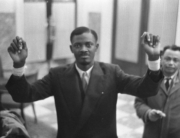Growing up in New Orleans, author Michael Lewis first discovered the works of Tom Wolfe on his father’s bookshelves when he was about 12 years old. “I grabbed the books because I thought there would be something dirty in them,” admits Lewis, who serves as the talking-head centerpiece in filmmaker Richard Dewey’s entertainingly appreciative, if ultimately unsatisfying, documentary, based on Lewis’s 2015 Vanity Fair profile, “How Tom Wolfe … Became Tom Wolfe.” The adolescent was immediately wowed by the writer’s distinctive style. “There was this (boom!) personality coming off the page,” Lewis recalls. “I remember wondering who wrote this. Who’s Tom Wolfe?”
The film seeks to answer that question by tracing Wolfe’s life and career through a mix of interviews with friends, family members, contemporary colleagues and rivals, and literary critics (Gay Talese, Lynn Nesbit, Christopher Buckley, Tom Junod, Niall Ferguson); archival footage of the dapper writer in his trademark white suit typing at his desk and being interviewed by William Buckley Jr. and Dick Cavett; and a narrative device of actor Jon Hamm reading excerpts from Wolfe’s greatest hits (Radical Chic, The Right Stuff, The Bonfire of the Vanities).
Perhaps the most revealing and rewarding sections of the film revolve around his rapid rise to magazine stardom in the 1960s, a Mad Men era when a magazine like Esquire, flush with advertising dollars, could pay Wolfe’s bill for a four-week stay at the Beverly Wilshire Hotel while he researched Southern California’s teen customized car culture. The irony is that Wolfe returned to New York with writer’s block. But as the magazine had already spent $10,000 printing the color photographs that were to accompany the article, editor Byron Dobell asked Wolfe to send his notes, and he would find another writer.
The letter that Wolfe sent, says Dobell, was a masterpiece and published, as is, in the November 1963 issue of Esquire as “There Goes (Varoom! Varoom!) that Kandy Kolored (THPHHHHHH!) Tangerine-Flake Streamline Baby (RAHGHHHH!) Around the Bend (BRUMMMMMMMMMMMMMM…”). This outrageous, breakout piece launched Wolfe’s career as an exemplar of the New Journalism, a term that the author had coined to describe using literary devices in nonfiction stories and that greatly irritated his rival, Hunter S. Thompson.
Fellow New Journalist Gay Talese describes Wolfe as a contradictory character: “Such a polite person. Such a well-mannered person. With a pen, he could be a terrorist.” At what point did his scathing critique of big-city elites cross the line into cruelty? Did he go too far in his skewering portrait of Leonard Bernstein’s fundraising party for the Black Panthers? Former Black Panther Jamal Joseph, whose bail was paid for by that fundraiser, provides an alternative perspective, but most of the focus here is on Wolfe’s penchant for killing the sacred cows of the intellectual left.
A radical prose stylist, Wolfe was a social conservative, which perhaps explains the bizarre presence of libertarian billionaire Peter Thiel, as the film delves lightly into Wolfe’s Southern roots and the outsider’s chip-on-the-shoulder attitude that he developed at Yale. Left unexplored is Wolfe’s childhood in the Jim Crow South. (“The desire to protect the reputation of that world is a very powerful thing,” notes Lewis.) One wishes the filmmaker had dug a little deeper. Likewise, Dewey touches only briefly on Wolfe’s personal life through interviews with his daughter, Alexandra, but the viewer gets no real sense of the man as a husband and father.
Could Wolfe be published in today’s politically correct world? The film barely addresses this question, but journalist Tom Junod praises Wolfe’s daring as a writer. “I don’t think anyone else took the chances that Tom Wolfe took, not only stylistically but also morally.”







Leave A Comment